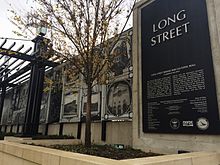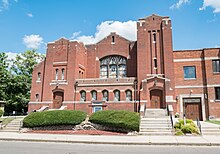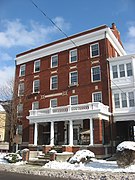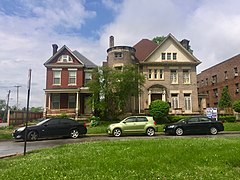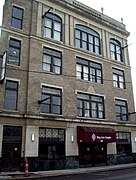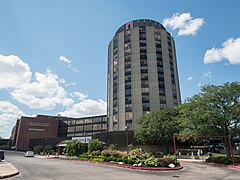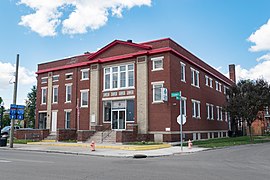
Douglas, on the South Side of Chicago, Illinois, is one of Chicago's 77 community areas. The neighborhood is named for Stephen A. Douglas, Illinois politician and Abraham Lincoln's political foe, whose estate included a tract of land given to the federal government. This tract later was developed for use as the Civil War Union training and prison camp, Camp Douglas, located in what is now the eastern portion of the Douglas neighborhood. Douglas gave that part of his estate at Cottage Grove and 35th to the Old University of Chicago. The Chicago 2016 Olympic bid planned for the Olympic Village to be constructed on a 37-acre (15 ha) truck parking lot, south of McCormick Place, that is mostly in the Douglas community area and partly in the Near South Side.
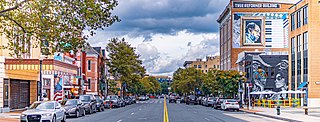
The U Street Corridor, sometimes called Cardozo/Shaw or Cardozo, is a commercial and residential district in Northwest Washington, D.C., most of which also constitutes the Greater U Street Historic District. It is centered along a nine-block stretch of U Street from 9th to 18th Streets, which from the 1920s until the 1960s was the city's black entertainment hub, called "Black Broadway" and "the heart of black culture in Washington, D.C.". After a period of decline following the 1968 riots, the economy picked up with the 1991 opening of the U Street Metro station. Subsequent gentrification diversified the population, which is 67% non-Hispanic White and 18% African American. Since 2013, thousands of residents have moved into new luxury apartment buildings. U Street is now promoted as a "happening" neighborhood for upscale, "hip", and "eclectic" dining and shopping, its live music and nightlife, as well as one of the most significant African American heritage districts in the country.

Italian Village is a neighborhood in Columbus, Ohio, that contains an array of residential, commercial, and industrial buildings. It is a designated historic district, known for its historical and cultural preservation. The building types and architecture reflect Italian influence. With its parks and preserved historic homes, Italian Village has the highest home value appreciation in Columbus.

The neighborhoods of Milwaukee include a number of areas in southeastern Wisconsin within the state's largest city at nearly 600,000 residents.
The Near East Side is a neighborhood located near downtown Columbus, Ohio, made up of several neighborhoods: Mount Vernon, King-Lincoln Bronzeville, Eastgate, Franklin Park, Nelson Park, Olde Towne East, and Woodland Park.

Downtown Columbus is the central business district of Columbus, Ohio. Downtown is centered on the intersection of Broad and High Streets, and encompasses all of the area inside the Inner Belt. Downtown is home to most of the tallest buildings in Columbus.

Olde Towne East is a neighborhood located in the historical Near East Side of Columbus, Ohio and is one of Columbus' oldest neighborhoods. The area has over 1,000 homes, some as old as the 1830s, and more than 50 architectural styles as a result of its history. These homes were built by many of the famous individuals of Columbus including industrialists, lawyers, judges, teachers, architects, mayors, governors, and legislators, many of whom shaped the city.
Columbus, the state capital and Ohio's largest city, has numerous neighborhoods within its city limits. Neighborhood names and boundaries are not officially defined. They may vary or change from time to time due to demographic and economic variables.

Mount Vernon is a predominantly African-American historic neighborhood in Columbus, Ohio, United States. The neighborhood lies within the historic Near East Side community, north of King-Lincoln Bronzeville. Mount Vernon borders Interstates 71 and 670. Its main thoroughfares, Mount Vernon Avenue, Long Street, Atcheson Street, and Champion Avenue define the community's limits.

The Lincoln Theatre is a 582-seat performing arts venue located at 769 E. Long Street in the King-Lincoln Bronzeville neighborhood of Columbus, Ohio. The theater is owned by the City of Columbus under the auspices of the Lincoln Theatre Association. Operation of the facility is managed by CAPA. It was listed on the National Register of Historic Places in 1992.

The Martin Luther King Jr. Performing and Cultural Arts Complex is a historic building in the King-Lincoln Bronzeville neighborhood of Columbus, Ohio. It was built in 1925 as the Pythian Temple and James Pythian Theater, and was added to the National Register of Historic Places and Columbus Register of Historic Properties in 1983. The building was renovated into the King Arts Complex in 1987, and was vacated in 2019. Community leaders restored the building's use as an arts center in 2021.
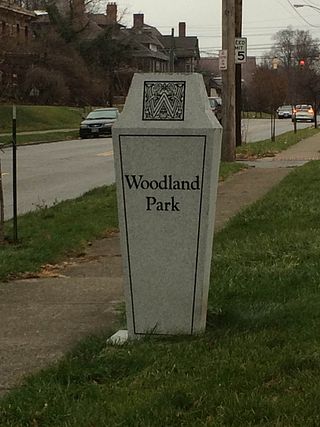
Woodland Park is a residential neighborhood located in the Near East Side of Columbus, Ohio that houses approximately 1,500 residents. The neighborhood was previously home to such figures as artist Emerson Burkhart, cartoonist Billy Ireland, and judge William Brooks. Established in the early 20th century, Woodland Park has grown from its planned neighborhood roots into a neighborhood that contains various faith communities, schools, sources of entertainment and recreation, and borders an extension of the Ohio State University medical center.

Shiloh Baptist Church is a historic Baptist church in King-Lincoln Bronzeville, Columbus, Ohio. One of the oldest black churches in the city, it has been active since the 1860s, and its 1920s building has been named a historic site.

Franklin Park is a neighborhood located on the Near East Side of Columbus, Ohio. Both the historic neighborhood and landmark, the Franklin Park Conservatory and Botanical Gardens, are named after the 88-acre park.
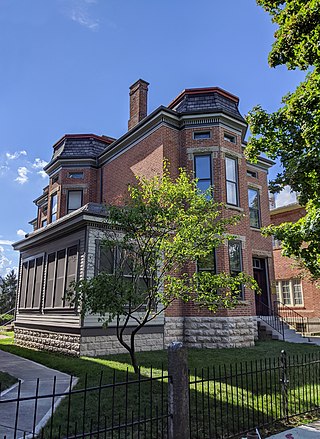
The Columbus Landmarks Foundation, known as Columbus Landmarks, is a nonprofit historic preservation organization in Columbus, Ohio. The foundation is best-known for its list of endangered sites in the city and its annual design award, given to buildings, landscapes, and other sites created or renovated in Columbus. It was established in 1977 as a project of the Junior League of Columbus, Ohio, following the demolition of the city's historic Union Station. It is headquartered at 57 Jefferson Avenue, a contributing structure in the Jefferson Avenue Historic District in Downtown Columbus.

The Edna is a historic building in the King-Lincoln Bronzeville neighborhood of Columbus, Ohio. It was built in 1905 and was listed on the National Register of Historic Places in 2017. The three-story brick building has 8,694 sq ft (807.7 m2). It was associated with the migration of African Americans to northern cities, including then-segregated Columbus. Businesses at the time had to cater to Blacks or whites; this building housed the Fireside Mutual Aid Association, an insurance company for Black residents. The building later housed the African American newspaper the Ohio Sentinel, as well as the Dukes and Duchesses, a private upscale social club for African Americans. The building is now owned by the City of Columbus, which requested proposals for the property from developers in 2009.
Bettye J. Stull is a curator, arts educator, and collector and is a pivotal figure in the Columbus Black arts community, known for her mentorship of young Black women, including artist April Sunami and activist Jessica Byrd. In her work as staff curator at the King Arts Complex, she was the founding director of the Elijah Pierce Gallery. Her other African and African-American art shows have appeared at the Ohio Craft Museum, the McCoy Community Arts Center, the Cultural Arts Center and several other area venues. She served as an art advisor for the Long Street Bridge “Culture Wall,” a collaboration between the City of Columbus, the Mid-Ohio Regional Planning Commission, and the Ohio Department of Transportation, which created an innovative arts-based solution to the long-standing problem of urban neighborhoods divided by freeways.
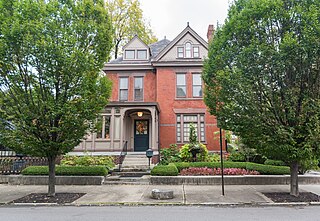
The Dr. Lewis M. Early Residence is a historic property in the King-Lincoln Bronzeville neighborhood of Columbus, Ohio. The house and office were listed on the Columbus Register of Historic Properties in 1984.

Second Baptist Church is a Baptist church in the King-Lincoln Bronzeville neighborhood of Columbus, Ohio. The church has the oldest African-American Baptist congregation in Columbus. It has been recognized as a historic underground railroad site by The Friends of Freedom Society and the Ohio Underground Railroad Association.
Ann B. Walker is an American journalist, editor, radio personality, and businesswoman. She is most notable for being the first woman broadcaster to report on the Ohio legislature for NBC4 and later becoming the first woman in broadcast management in the city's and stations' history. She was inducted into the Ohio Women's Hall of Fame as the first woman broadcaster to report on the Ohio Legislature in 1978. She is also the first Black woman from Franklin County to receive a presidential appointment.




